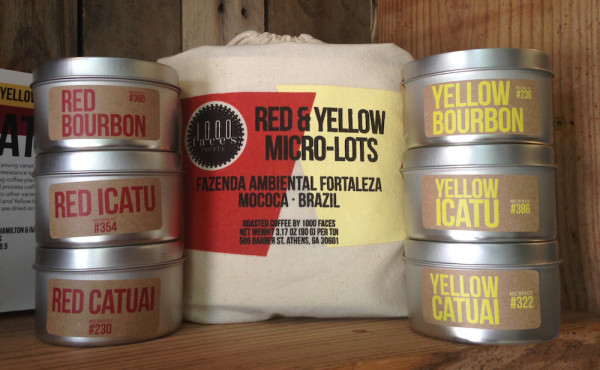There is a trend emerging in specialty coffee right now that not only reflects unprecedented farm-level ingenuity, but also unprecedented consumer interest in tasting experiences.
I’m speaking of “limited” and “reserve” packages featuring different varietals from a single farm packaged tightly together and sold at a premium. Madcap’s Varietal Series and Intelligentsia’s Cafe Inmaculada series immediately come to mind, with high-priced tins packed with side-by-side varietals from a featured producer.
Now Athens, Ga.-based 1000 Faces takes a turn, with the Fazenda Ambiental Fortaleza Red & Yellow Microlot Series, the result of the company’s longstanding relationship with the Brazilian farm. We asked 1000 Faces’ Ben Myers about the Red & Yellow series, which reflects a new kind of product for the company.
(related: The Difference Between Counter Culture’s Holiday Coffee and Trader Joe’s Candy Cane Joe Joes)
Can you tell us about your connection to the farm, as well as what makes these coffees special?
Fazenda Ambiental Fortaleza and 1000 Faces share the same ethos when it comes to land use, community development, and the importance of spirit in all matters. I connected with the family six years ago through a shared friend, we see eye to eye and share mentors such as Fritoj Capra and Rudoph Steiner. I think shared values are the greatest connector of any two organizations. Though beyond the relationship, it is important how radical their approach to coffee is in Brazil, in terms of their active and passive organic farming techniques, varietal separation, and feedback through intensive lot cupping and separation. They maintain a grass roots and convivial essence, while scientifically and methodically implementing progressive farming with human and ecological values at the center.
What did you hope to convey with the packaging of the finished product?
While cupping these different lots in Brazil with Felipe Croce, I got the idea to create a red and yellow dichotomy and to further indicate the distinction by having three varietals on each side of the cherry spectrum to compare and contrast. The set was designed replicate the cupping table experience I was enjoying in tasting the different varietals side-by-side. This packaging is emblematic of that experience.
What do you make of this kind of micro-trend among roasteries? Are these kinds of products a reflection of increased interest among consumers in farm-level specifics?
I was lucky enough to spend time with Ryan Knapp of Madcap in Colombia last year and got to chatting with him about a similar package his company had offered through a farm they work closely with in El Salvador. Once he let me know how well the consumer market had responded to his offering, I felt more confident that there were coffee drinkers interested in the same things that I was geeking out over. I think consumers like to have the opportunity to learn and co-produce the lexicon of shared experience. The more clearly you can help facilitate that experience, whether it be by farm or varietal, the more able they are to participate.
You’ve mentioned that the coffee package include stories from you. What might those stories involve and why are you telling them?
It’s a ghost story. I was lucky enough to have spent time with Ken Kesey growing up, and he once told me that on a walk across his farm that “hay was psychedelic.” When I looked up he was gone, though the farm was still there and so was his spirit. For me, that is the essence that makes the river of fiction and reality so great. Great coffee, place, and narrative come naturally. We are always telling stories one way or another.
Nick Brown
Nick Brown is the editor of Daily Coffee News by Roast Magazine.







Comment